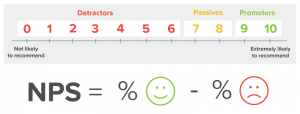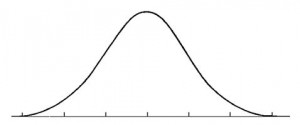Back in September we wrote an article on customer satisfaction and the Net Promoter Score (NPS) – a measurement mechanism that organisations use to determine how satisfied their clients are, which is as a consequence a lead indicator of their future buying habits.
There are numerous such mechanisms for measuring customer satisfaction. What’s great about NPS is its simplicity, as it asks just one question, the answer to which tells us an awful lot:
“On a scale of 0 to 10, how likely are you to recommend this company’s product or service to a friend or colleague?”
The responders are then divided into three categories: detractors, passives, and promoters:

Detractors score from 0 to 6, and are clearly not happy. They will not make a positive recommendation and in all probability will make a negative one!

Passives score 7 or 8. They are broadly neutral. They probably wouldn’t say anything negative, but aren’t enthusiastic enough to say anything positive either.

Promoters, who score 9 or 10, are positive and enthusiastic about the company’s products and services, and will make positive recommendations to other potential buyers, often proactively.
The NPS score is calculated by subtracting the percentage of customers who are detractors from the percentage who are promoters, thus arriving at a score between -100 and 100.

Good to great …
Having reminded ourselves what NPS is, let’s dwell for a moment on what we do with the data. It’s not much use if we find out that we’ve got a lot of detractors and passives and we don’t do anything to improve customer satisfaction. Similarly, if we have promoters and don’t exploit that opportunity – we haven’t gained anything.
So, acting on the data is the really smart thing to do.
Culturally, we seem to spend a disproportionate amount of time trying to improve things that aren’t very good, or are downright bad, and moving them to a position of acceptable mediocrity.
We’re all familiar with the so-called “bell curve” (or normal distribution for the statisticians) of performance:

Huge (and quite often ineffective) effort is generally spent trying to move people (whether they are unhappy clients or under-performing staff, or whatever) from the left towards the centre. Far less effort is spent moving people from the centre towards the right … and even less on people already on the right towards the far right.
The best organisations are already good, but are always striving to be great. They don’t just look at the data – they act on the data. It’s that “Better Never Stops” mantra that the British Olympic Association used so effectively at London 2012. One such organisation is Calderstone – passionate about customer satisfaction – who listen very carefully to their customers and act quickly and decisively to move from good to great.
Calderstone’s results
In their most recent NPS survey – and it’s worth pointing out that these surveys are carried out by independent agencies to avoid bias and protect confidentiality – Calderstone’s score increased from 51 to 55, a truly excellent result.
Here are some comments from existing customers:
- “We like Calderstone very much.”
- “Absolutely brilliant, both Lisa and Martin are great and provide excellent service.”
- “Do shop around but come back to Calderstone due to service.”
- “Have just recommended them today!”
- “Use them all the time!”
So here it is in a nutshell – Calderstone delights its customers … and if you want to find out how click here for their home page or give them a call on 01737 458 123
Merry Christmas!
We wish all of our customers a Merry Christmas and a Happy New Year, and look forward to catching up again in January.

